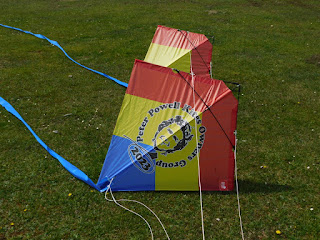If you see this label for a dual-line kite, "Peter Powell" isn't the first name that comes to mind, is it?
But strange though is may seem, there is a Peter Powell connection .... The Nastie One was made by the Caribbean Kite Company, the US arm of Peter Powell kites once they became 'independent', and is the kite in my collection which is clearly the furthest away from the classic Peter Powell Stunter.
Here's Nastie One on the ground ...
If you name one of your kites Nastie One, it suggests there is also at least a Nastie Two, doesn't it? Yes, there was indeed a Nastie Two! It was said to be green, and that's all I know about it; despite a lot of googling and using the wayback machine, I couldn't find a picture anywhere. However, this single-line kite was marketed by the CKC under the name 'Frank':
Look at the hands of 'Frank' .... they're almost identical to the hands on the Nastie One .... And 'Frank' is green .... So it's possible that the Nastie Two looked similar to 'Frank' .... Maybe one day I will have a pair of Nasties to fly together; I will certainly keep my eyes out for that!




































